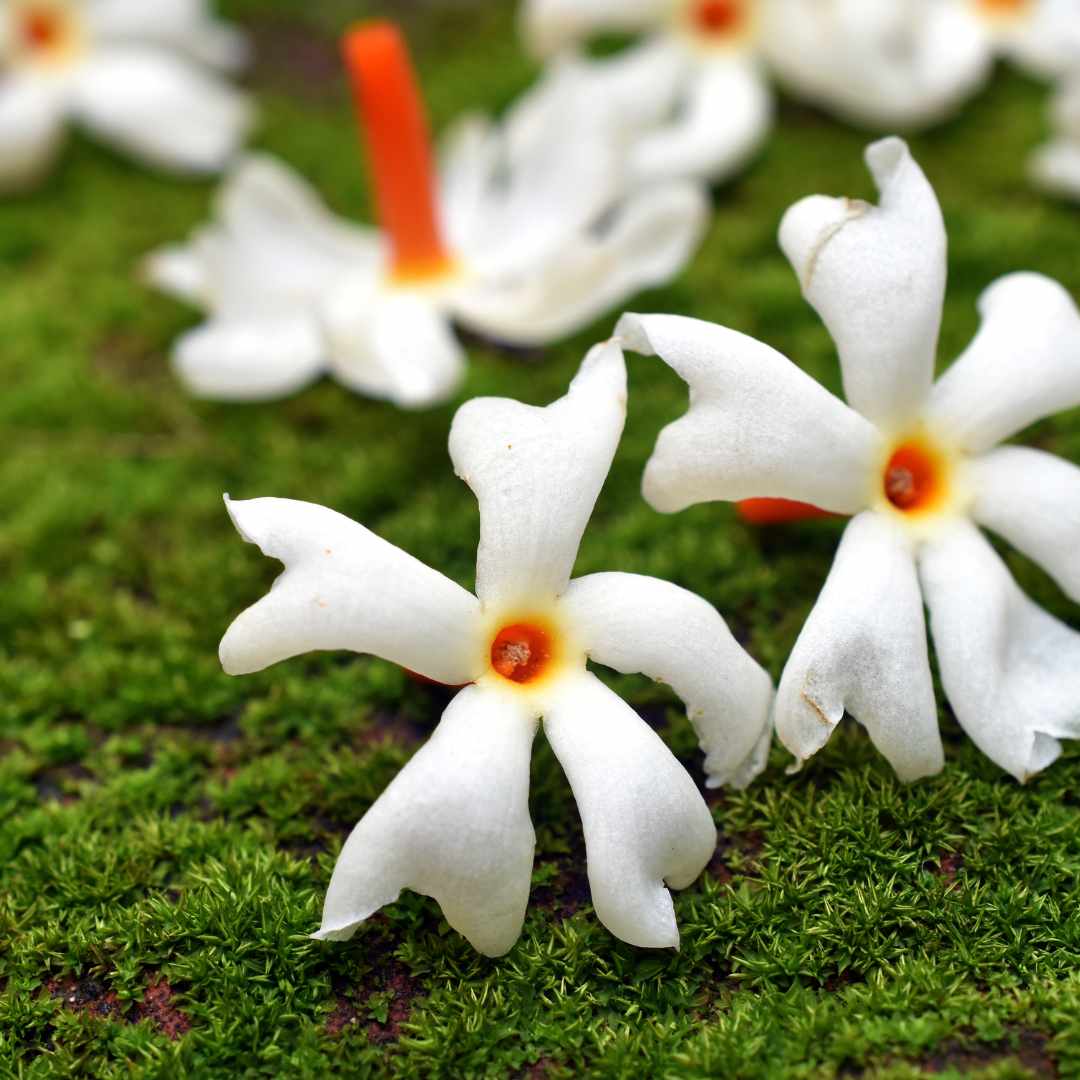
Prajakta Flowers: Secrets of the Night-Blooming Jasmine Harsingar
Share
In the lush landscapes of India, there exists a mystical flower that has captured the hearts and minds of many—the Prajakta flower, also known as Parijat, Parijatak, Harsingar and Night Blooming Jasmine. This article delves into the rich world of Parijat flowers, exploring their mythological significance, spiritual connections, health benefits, and the captivating story that intertwines them with the divine.
What is a Parijat Flower?
The Parijat flower (Nyctanthes arbor-tristis), also called Prajakta, Night-flying Jasmine, Coral Jasmine, Harsingar, or Paarijat, is a fragrant blossom that graces the Indian subcontinent with its unique charm. Let's explore the various facets of these enchanting flowers and unravel the secrets they hold.
Mythological Story: Krishna and the Parijat Tree
One of the most captivating tales associated with Parijat flowers is the legend of Krishna and the Parijat tree. According to Hindu mythology, the Parijat tree was a celestial tree that emerged during the churning of the ocean (Samudra Manthan). Krishna, drawn to its exquisite beauty, decided to plant it in his courtyard. The tree, however, belonged to Indra's garden, leading to a celestial conflict. Eventually, Krishna's devotion won, and the tree found its place in his abode.
Spiritual Significance and Cultural Connections
Barabanki Temple: A Living Legend
In the town of Barabanki, Uttar Pradesh, stands a temple that houses a 5000-year-old Parijat tree. Believed to be the wish-fulfilling Kalpavriksha, this ancient tree is associated with Kunti, the mother of the Pandavas, who is said to have cremated herself near it. The temple hosts a special fair every Tuesday, where devotees gather to worship the Parijat tree.
Govedic: To enhance your spiritual experience, consider using Govedic's Parijat Attar Night Jasmine Perfume Oil. This fragrant attar is crafted to evoke a sense of divine connection during your spiritual activities.
Parijat in Indian Households
The Parijat flower holds a special place in Indian households. Beyond its ornamental value, it is deeply ingrained in local traditions and cultural practices. Hindu families often use Parijat flowers for home decor, pooja etc. reflecting the flower's versatility in both spiritual and aesthetic realms.
Health Benefits and Medicinal Properties
Ayurvedic Marvel: Parijat's Medicinal Bounty
Ayurveda, the ancient Indian system of medicine, recognizes the medicinal properties of Parijat flowers. These include anti-inflammatory, anti-diabetic, and antioxidant characteristics. The leaves, in particular, are known for their night-jasmine fragrance and antioxidant properties.
Health Benefits of Parijat Flowers:
- Fever Relief: Parijat is known to alleviate fever symptoms.
- Arthritic Knee Pain: The flower is believed to provide relief from arthritic knee pain.
- Immunity Booster: Parijat acts as an immunostimulatory agent, enhancing overall immunity.
Snake Bites and Parijat's Healing Touch
Traditionally, Parijat has been associated with snakebite treatment. The plant's leaves are believed to possess anti-venom properties, offering natural healing for those bitten by snakes.
Plant Care Tips: Nurturing Your Parijat
To fully enjoy the beauty and benefits of Parijat flowers, it's crucial to understand how to care for these mystical plants. Here are some plant care tips:
Fertilizing: Provide your Parijat plant with the nutrients it needs by using organic fertilizers. Annual fertilizing will contribute to soil enrichment and overall growth enhancement.Pruning Techniques: Regular pruning ensures a well-maintained and healthy Parijat plant. Learn the art of pruning to enhance blooming and maintain its desired shape.
Soil Care: Parijat plants thrive in well-draining soil. Ensure proper soil care to prevent waterlogging and root rot.
Frequently Asked Questions (FAQs)
What is Parijat Flower Called in English?
The Parijat flower is commonly known as Night-flowering Jasmine, Coral Jasmine, Harsingar, or simply Parijat.
What is Special About Parijat Flower?
The Parijat flower is renowned for its enchanting fragrance, mythological significance, and its association with spiritual and medicinal practices.
Which God Likes Parijat Flower?
Lord Krishna is particularly fond of the Parijat flower, as evidenced by the mythological story of Krishna and the Parijat tree.
Why is Parijat Tree Famous?
The Parijat tree gained fame due to its celestial origin, as depicted in Hindu mythology, and its connection to the divine through the stories associated with Lord Krishna.
Is Parijat Plant Lucky?
In many cultures, the Parijat plant is considered auspicious and is believed to bring good luck and prosperity to the households that nurture it.
Why Parijat is Called the Tree of Sadness?
The Parijat tree is sometimes referred to as the "Tree of Sadness" because of the belief that its flowers never touch the ground. They bloom at night and fall in the early morning, giving the impression of tears.
Does Parijat Flower Smell?
Yes, Parijat flowers have a delightful fragrance, especially during the night when they bloom. Check this Govedic's Parijat Attar Night Jasmine Perfume Oil
Can We Grow Parijat in Pots?
Yes, Parijat plants can be grown in pots, making them suitable for both indoor and outdoor cultivation. Ensure proper soil, sunlight, and water conditions for optimal growth.
What is the Story of Parijat Flower in Krishna's Life?
The story involves Krishna's admiration for the Parijat tree's beauty, his attempt to transplant it to his courtyard, and the celestial conflict that ensued, ultimately leading to the tree finding a place in Krishna's abode.
Does Parijat Bloom at Night?
Yes, the Parijat flower blooms at night, releasing its captivating fragrance during the dark hours.
Can We Eat Parijat Flower?
While Parijat flowers are not typically consumed, they hold significance in traditional medicine for their health benefits.
Should We Plant Parijat at Home?
Planting Parijat at home is a wonderful idea, given its cultural, spiritual, and health-related significance. It adds beauty to your surroundings while bringing positive energy.
Is Parijat and Raat Rani the Same?
Yes, Parijat and Raat Rani refer to the same flower, known for blooming at night and emitting a mesmerizing fragrance.
Can We Eat Parijat Leaves?
While not commonly consumed, Parijat leaves are known for their medicinal properties, including antioxidant and anti-inflammatory effects.
What is the Lifespan of Parijat Tree?
The lifespan of a Parijat tree can vary, but with proper care, these trees can live for several decades, becoming a timeless part of your garden or landscape.
Conclusion
In the realm of flowers, the Parijat stands out as a symbol of beauty, spirituality, and healing. From its mythological roots to its presence in diverse cultural practices, the Parijat flower continues to weave tales of enchantment. Whether adorning a temple courtyard, gracing an Assamese household, or blooming in your own garden, the Parijat flower remains a celestial gift that transcends time and space.
Disclaimer: This content provides generic information only and is not a substitute for qualified medical advice. Always consult with a healthcare professional for personalized guidance.
Note: The mentioned brands are for illustrative purposes, and it's advisable to explore and choose products that align with your preferences and dietary requirements.
